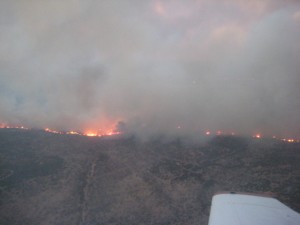This has become the “Spring of Fire” in Texas. One may only hope that it doesn’t become the “Summer of Fire” too.
I heard on the TV news this morning that all but two Texas counties were touched by wildfires. I don’t know which were the lucky two of 254 counties, but it would seem the chances were good for all 254 to end up in blazes.

Firefighters have been battling a blaze of more than 7,000 acres about 30 miles north of where I live. This fire or fires in Hardin and Tyler counties have threatened more than a couple of dozen homes, according to local media reports. It is hard to say, but luck, skill of those fighting the fires and perhaps a combo of the two have kept homes from also going up in flames in that local fire.
The fires have threatened at one time or another a part of the Big Thicket National Preserve where I have gone for winter hikes on several occasions. I mention “winter” because most people with any sense wouldn’t hike in that tangle of flora and creek bottoms during Summer. Sure, it would be a shame if fires ran through the Turkey Creek Trail in the Thicket, just as it was a shame some of my other favorite hiking areas were shut down after Hurricanes Rita and Ike.
Nature has been taking care of things there in the Thicket and in other East Texas woods for many, many years, though. So far the forests have managed to come back as good as ever. One might note, the natural areas of the Sabine-Neches watershed fared much better over the years in its bouts with nature than it has in tussles with man.
Mostly urbanized and suburbanized American folks have to be reminded at times that nature was the woods and prairies and plains own personal gardener before man moved in started messing with the natural order of things. Progress? I guess.
My worst allergy is from the tree, or shrub, named Ashe juniper but is better known by its nickname, mountain cedar. Thankfully, those irritating abominations aren’t found here in deepest eastern and Southeast Texas. It is found in abundance in Central Texas where I once lived. One time when I worked out there a fellow told me that this scourge of mountain cedar has grown to such excess because people farmed those lands and, as they do today, did all that was possible to extinguish those fires and save the homesteads. As a result the Ashe juniper flourished there while the natural wild native grasses went unseen for years.
My guide told me that the lightning-induced fires that burned the lands before man came along to put out the fires created a natural cleansing for native plant life. How much all of that is true, I don’t know, nor care for that matter. For that type of life cycle plays out worldwide.
It is great my neighbors to the north have not been burned out of their homes. Perhaps it also is a tad unnatural, which is probably a bit blasphemous for me to say so, coming from one who once worked risking his life to save the property of others from fire. But that’s the way it is and the way it will always be until it isn’t the way anymore.

Spelling error report
The following text will be sent to our editors: